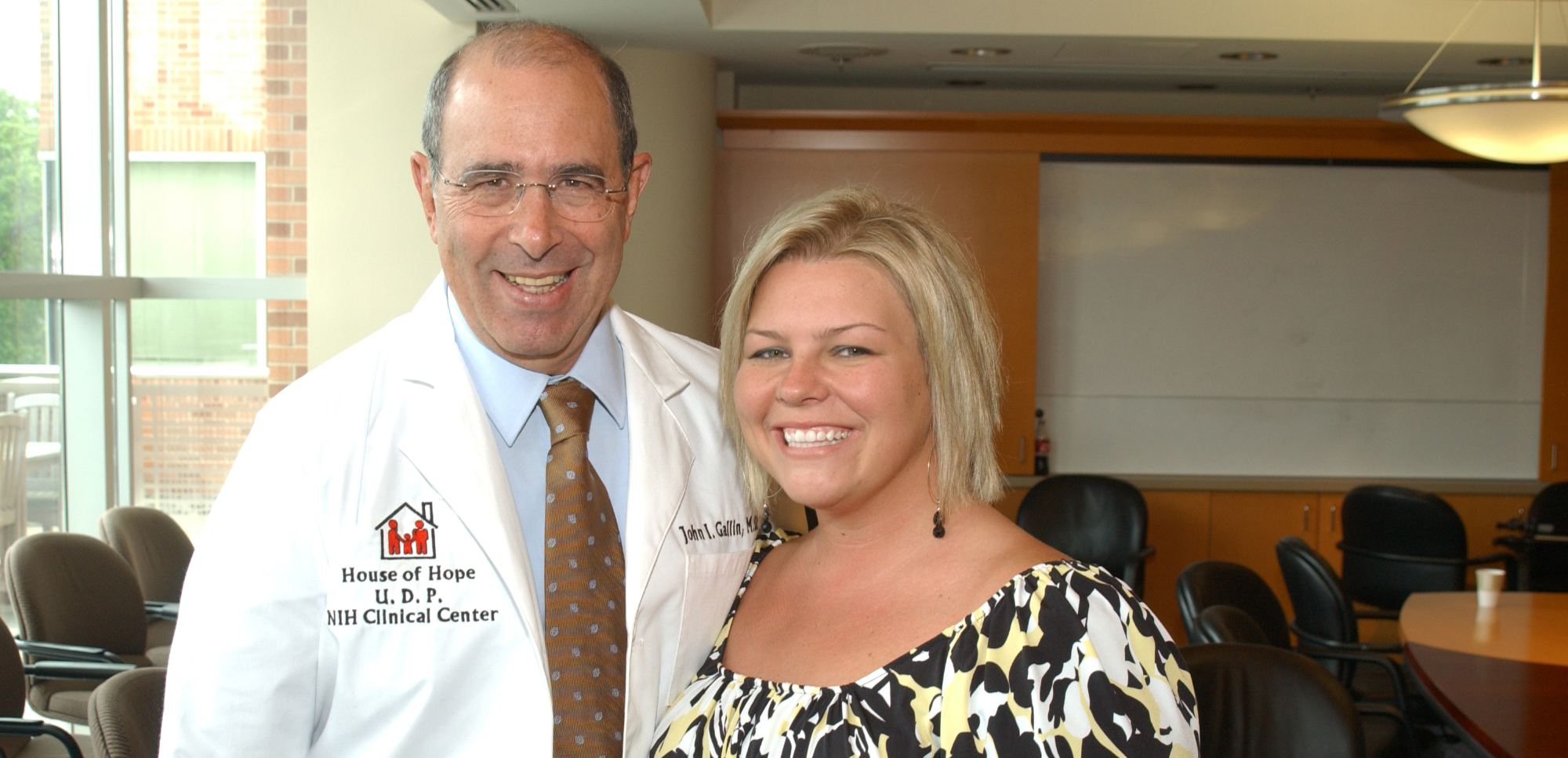Content on this webpage is provided for historical information about the NIH Clinical Center. Content is not updated after the listed publication date and may include information about programs or activities that have since been discontinued.
A Place for Hope: Mandy’s Story
 CC Director Dr. John I. Gallin and his patient, Amanda Young, at the Undiagnosed Diseases Program’s launch on May 19, 2008.
CC Director Dr. John I. Gallin and his patient, Amanda Young, at the Undiagnosed Diseases Program’s launch on May 19, 2008.
Amanda Young, 26, of Conyers, Ga., lived her young life as a mystery. Seeking an explanation for having contracted spinal meningitis, gas gangrene, salmonella poisoning of the sinuses, an abdominal abscess, and more, Amanda finally found an answer at the Clinical Center.
Years of intensive testing led to a diagnosis of an IRAK-4 deficiency. An extremely rare genetic mutation affects her body’s ability to create a protein needed to fight bacteria, leaving her vulnerable to life-threatening infections. The oldest of only about 20 patients known to have the deficiency, Mandy seems to have put the worst behind her.
Her first years were marked by three cases of meningitis and an abdominal abscess the size of a cantaloupe. Doctors couldn’t tell Mandy’s parents, Lisa and Speed Young, why their daughter was brought to the brink of death every few months.Desperate for answers, the Youngs traveled across the Southeast visiting doctors and researchers. There were no answers. At age 8, Mandy faced another devastating illness. A cut on her leg did not heal correctly and she developed a massive infection caused by toxin-producing bacteria. The toxin — gas gangrene — forced a complete amputation of her left leg and hip.
“The infection spread faster than they could get the lab test results back. It was horrible, simply horrible. Because the gases were moving up her leg so quickly, doctors amputated the entire leg through the hip joint. She was hospitalized for months,” Lisa Young said.
Though frustrated, the Youngs were far from giving up hope. A doctor in Atlanta recommended the case to Dr. John I. Gallin, now CC director.
In August 1990, Mandy made her first of many visits to NIH. She traveled here every six weeks for blood tests and studies, then once every three months, to twice a year.“I’ve been sort of a lab rat for years. But that’s the only way that they can help me. And it’s okay with me. I love the fact that I am making a contribution to science and to myself at the same time. I would much rather it be me, than someone else,” Mandy said.
“On May 13, 2003, at 8:24 am, Dr. Gallin told us, ‘Congratulations! At long last we have figured out the basis of Amanda’s problem.’ I began to shake, and the tears wouldn’t stop,” Lisa said.
After 21 years of questions, Mandy had an answer. The meeting where the team of researchers who had worked on her case revealed their finding to the Youngs was an emotional one.
“We were in shock, then ecstatic,” Mandy said. “Dr. Gallin promised he wouldn’t give up on me, and he didn’t. After 13 years of intensive studies, my immune deficiency had a name.”
The Clinical Center exists for people like Mandy and her parents, Gallin said. “Our patients are partners in medical discovery. They call this the House of Hope. Our commitment to them is to marshal medical and scientific expertise, resources, and care in the search for answers. In a research setting, one patient’s answers often generate new avenues for medical advancements that ultimately help others.”
Mandy has more to be happy about these days. Her condition seems to improve as she ages. While the gene defect has been found, research continues into the cause, treatment, and cure of the IRAK-4 deficiency. Mandy must be acutely aware of her body, as the smallest ache or sense of fatigue could mean a fatal infection has grown without detection.
Entering a career in motivational speaking, Mandy is positive about her future.
She looks forward to visiting her CC “family,” and is ecstatic that the NIH Undiagnosed Diseases Program will be in place to help others like her.
“This new program will be more than a place for families to come for help,” Mandy said. “It will be their place to come for hope.”

